Doona Rear-Facing Only Infant Car Seat & Stroller Review

![]()
![]()
![]()
![]()
![]()
Doona Car Seat & Stroller Review
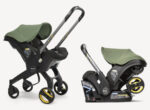 The Doona Car Seat & Stroller* took the carseat world by storm when it was introduced nearly 10 years ago; however, it wasn’t the first carseat with integrated stroller (we won’t discuss that monstrosity here 😜). For parents living in large cities and relying on taxis and rideshares, the Doona is a total game-changer: there’s no need to drag around an extra piece of equipment, whether it’s a stroller or a carseat.
The Doona Car Seat & Stroller* took the carseat world by storm when it was introduced nearly 10 years ago; however, it wasn’t the first carseat with integrated stroller (we won’t discuss that monstrosity here 😜). For parents living in large cities and relying on taxis and rideshares, the Doona is a total game-changer: there’s no need to drag around an extra piece of equipment, whether it’s a stroller or a carseat.
*As Amazon Affiliates, anytime you make a purchase through one of our links, we earn a small commission at no cost to you. Thank you for reading our articles and supporting CSB!
As for traveling, it can be especially convenient when flying if you’re lucky enough to be able to wheel it down the aisle of the airplane (this is hit or miss depending on the width of the aisle). The Doona is FAA-certified and can be used on any US air carrier, as long as if you buy a ticket so your child can have their own seat.
Unfortunately, Doona has become so popular that it has spawned a million dangerous fakes. In order to be sure that you are getting a legitimate, safe product, only purchase at authorized Doona retailers. If you see something similar that looks like a “deal,” it’s probably a dangerous counterfeit.
There is now another choice in the carseat/stroller combination world: Evenflo’s Shyft DualRide. In this review, we’ll focus on the Doona, but we have a comparison between the Doona and the Shyft DualRide here.
Doona Specs & Features:
Rear-facing only: 4-35 lbs.; 32” or less and head must be 1” below top of seat
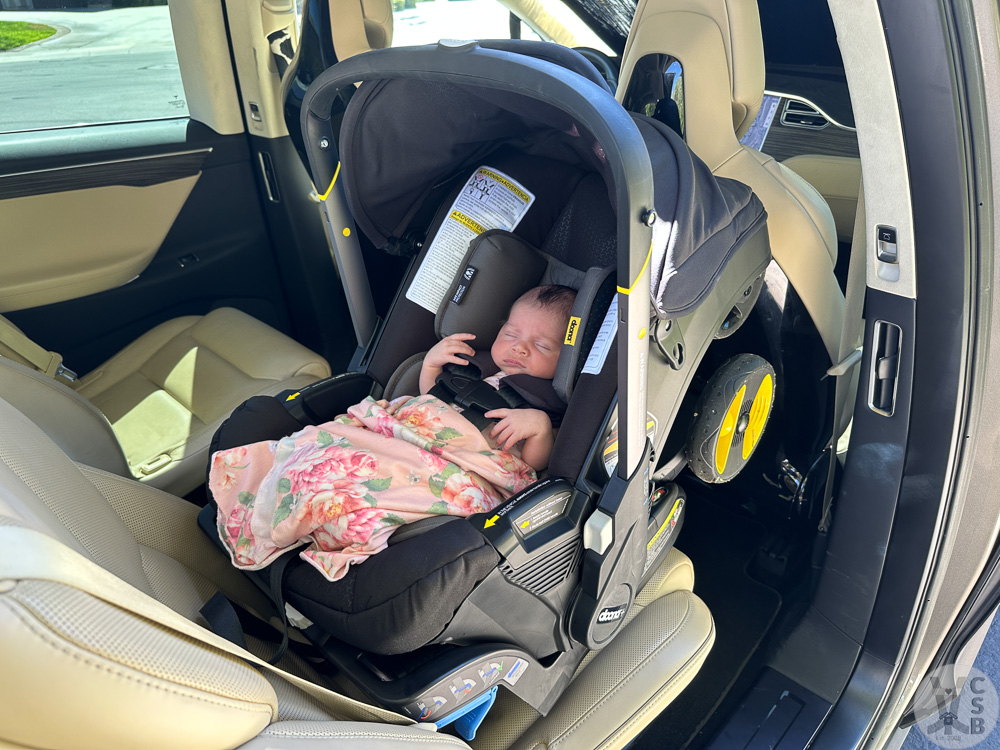
3 harness height positions
1 crotch strap/buckle position
Thick energy-absorbing EPS foam
Anti-rebound handle position
Euro belt path allowed when installed without the base
Push-on LATCH connectors
FAA-approved for use in an airplane without the base
SensAlert Bluetooth child detection system add-on available
Follows NHTSA guidelines for replacement after a crash
6 year lifespan before expiration
Made in China
MSRP $550.00 for Core model (7 colors), which includes car seat and base, plus vehicle seat protector
MSRP $650 for Midnight model (1 color), which includes a deluxe black fabric with a diamond shape quilted in, black anodized aluminum, faux leather details, a vehicle seat protector, and a Midnight Essentials Bag
MSRP $700 for limited edition Doona x Vashtie, which features a canopy and cover designed by Vashtie with handwritten details, black anodized aluminum, Vashtie handlebar cover, a Vashtie Signature keychain, a vehicle seat protector, and an Exclusive Essentials Tote Bag.
Available accessories, such as covers and storage bags can be found here.
Doona Measurements:
Harness slot heights: 7 ½”, 10”, 12”
Lowest harness slot height without body insert: 8”
Crotch strap/buckle positions (without insert): 4 ½”
Internal shell height: 21”
Length of base footprint: 17 ¾”
Width of base at widest point: 15 ¼”
Width of carrier at widest point: 17 ½” (outside of handle)
Carrier weight: 17.0 lbs. with insert, 17.2 lbs. with insert and SensAlert; 16.8 lbs. without insert
Fit-to-Vehicle:
Removing the Doona from the base is a 2-step process and is a little different than most rear-facing only infant seats. The release handle is on the end of the dated-looking base and you press down on a button while pushing in on the handle, then lift the seat off. It sounds complicated, but it really isn’t.
A green indicator shows when the seat is fully engaged on the base. Any red on the indicator shows that something is not clicked in.
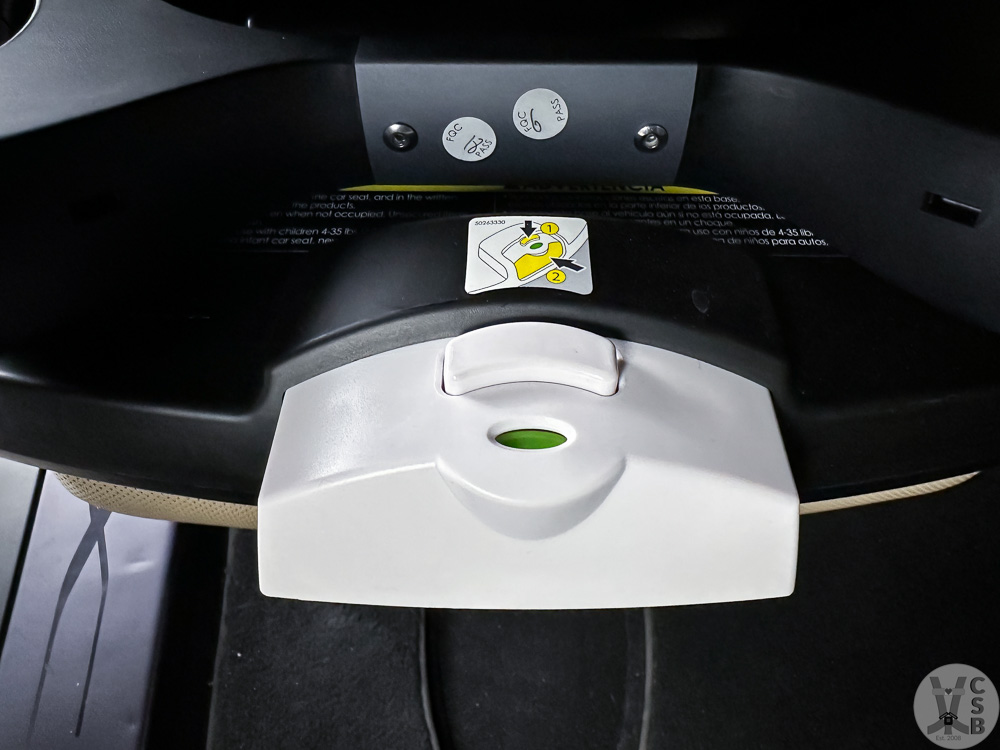
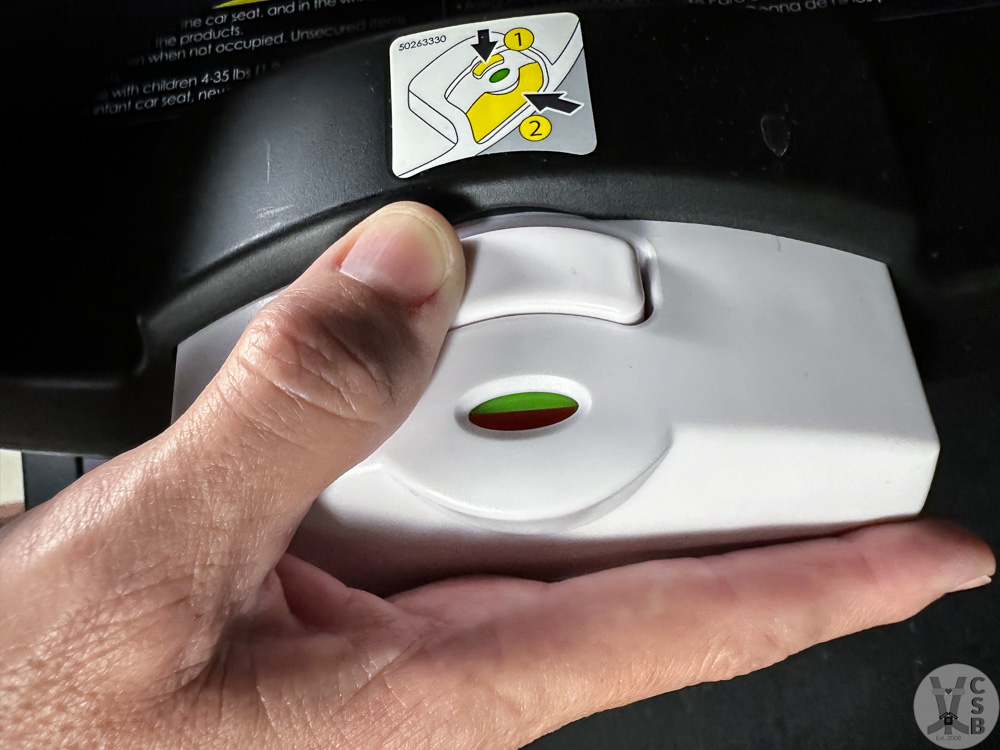
Recline angle indicator – There is a pendulum recline indicator on both sides of the base.
For installation without the base, there is a red level line indicator sticker on each side of the carrier.
Noodles/Rolled towels – Allowed. If the built-in recline foot isn’t sufficient, put the foot back into its storage position and use noodles or a rolled towel.
Overhang – There’s no mention of overhang in the manual, so assume the 80/20 rule: no more than 20% of the base may hang over the vehicle seat edge.
Installation with LATCH – Use either LATCH or the seat belt to get the tightest installation in your desired seating position, but don’t use both at the same time (it’s right there on pg. 15 and pg. 16 in the base manual).
The Doona base has deluxe push-on LATCH connectors that look like staplers. Make sure they’re upright when you push them on the lower anchors.
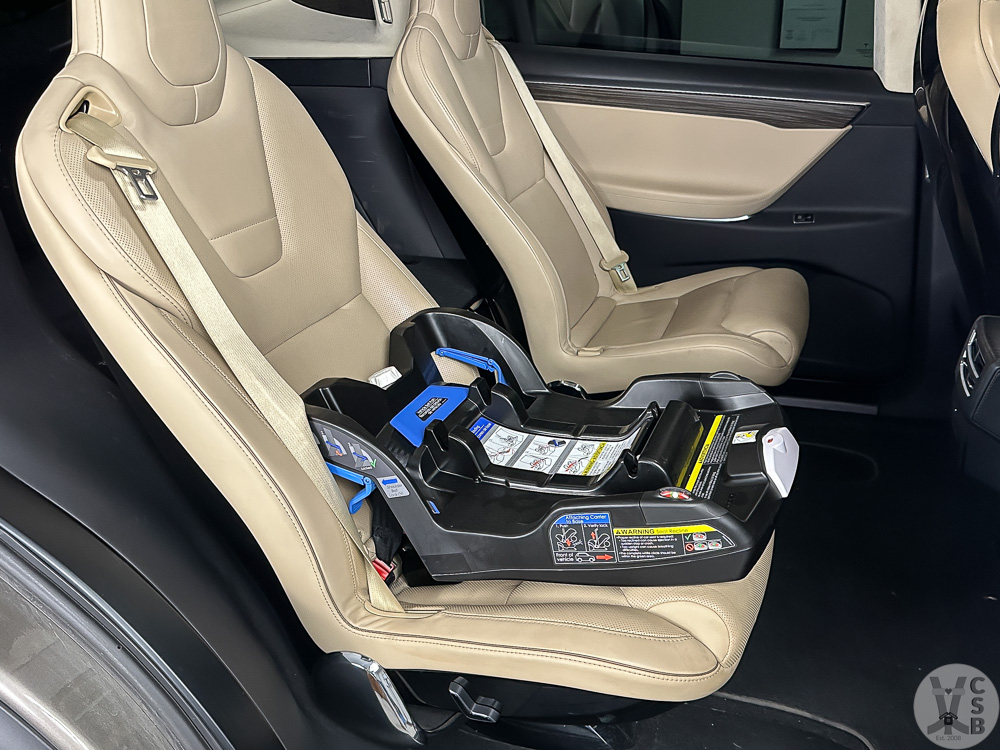
Center LATCH installation with non-standard LATCH spacing: Not allowed. We always put this in our reviews, but you really don’t want to install this in the center anyway since it’s such a heavy seat AND it’s a convenience seat meant to be popped out of the vehicle.
Installation with seatbelt – On each side of the belt path is a blue “lock-off.” These are not true lockoffs, which lock the seat belt tight so that the base doesn’t move during daily driving. The manual specifies using the “lock-off” on the side opposite the buckle, then locking the seat belt. I imagine this is to keep the base from tipping by the shoulder belt pulling up on the belt path. I wish they wouldn’t call it a “lock-off.” It’s not and waters down the definition of one. Sigh.
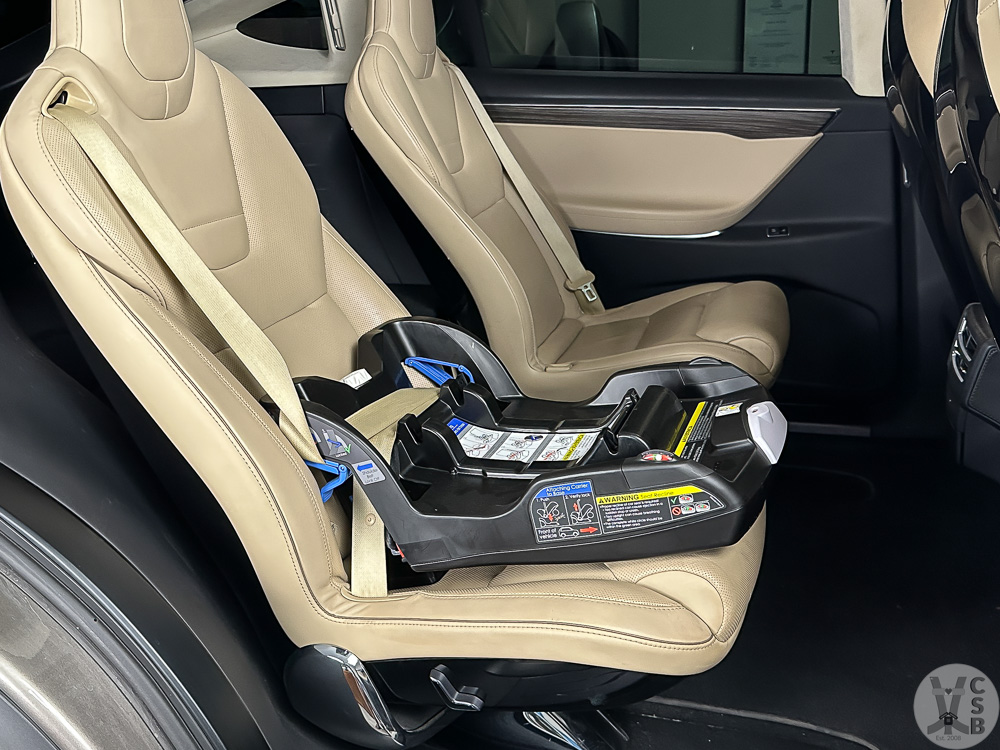
Inflatable Seat Belts
Doona has determined that the Car Seat and Stroller can be installed with inflatable seat belts found in some Ford Motor Company and Mercedes vehicles. Follow the standard lap/shoulder belt instructions. When installing the base, close the blue lockoff first, then route the shoulder belt over the top of it.
Installation without base – The Doona carseat can be installed safely without the base using the typical American belt routing method OR the Euro method. Using the American method, the carrier is secured directly to the vehicle with the lap portion of the seatbelt (do NOT place the shoulder belt through the belt path). This is very handy if you’re traveling by taxi or airplane. No need to lug the base around with you, and why would you with your carseat on wheels? However, you have to know how to lock the seatbelt in the vehicle that you’re going to be riding in (hint—most lock by pulling the shoulder belt all the way out slowly and letting it retract back in slowly).
With the Euro method, the lap belt also goes through the belt path across the top of the carrier, but the shoulder belt routes behind the back of the seat instead of resting against the back of the vehicle seat. This usually ensures a very stable installation where the seat stays more upright in a frontal crash.
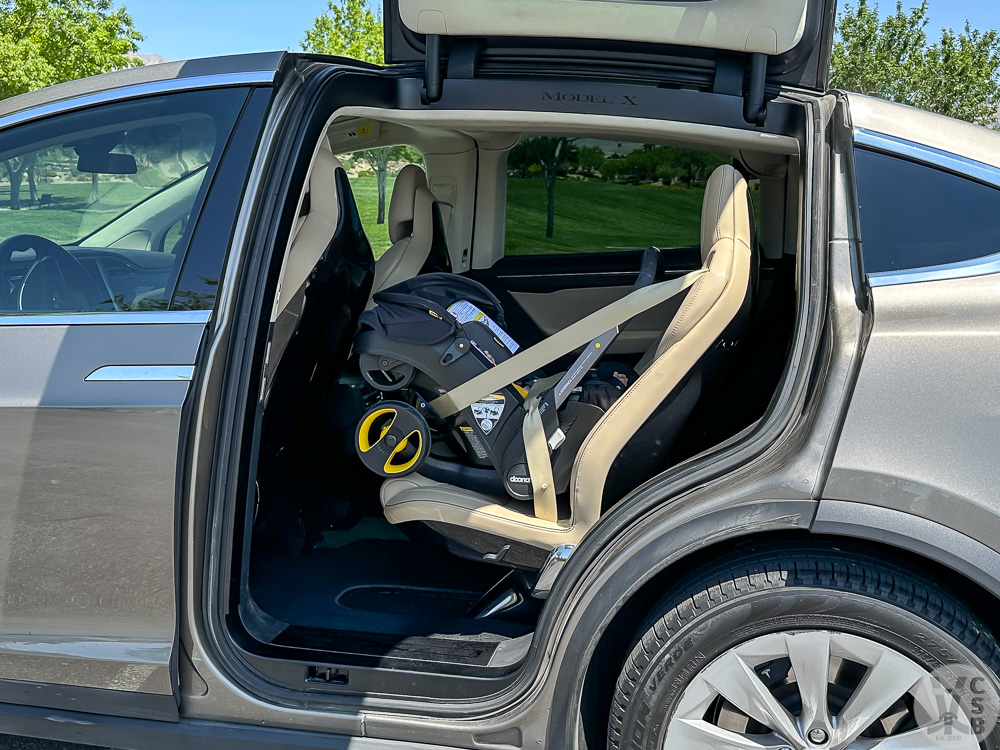
Handle – In the vehicle, the handle must be forward, toward the child’s feet (so it acts as an anti-rebound handle; see pg. 18 in the manual).
On the ground when you’re placing your child in the carseat, the handle may be upright or behind the child’s head in a locked position.
In stroller mode*, the handle may be upright or toward the child’s feet.
*The handle won’t rotate if it’s extended. If it won’t move, press the button on top of the handle to lower it before pressing the buttons on the handle hubs simultaneously for rotation.
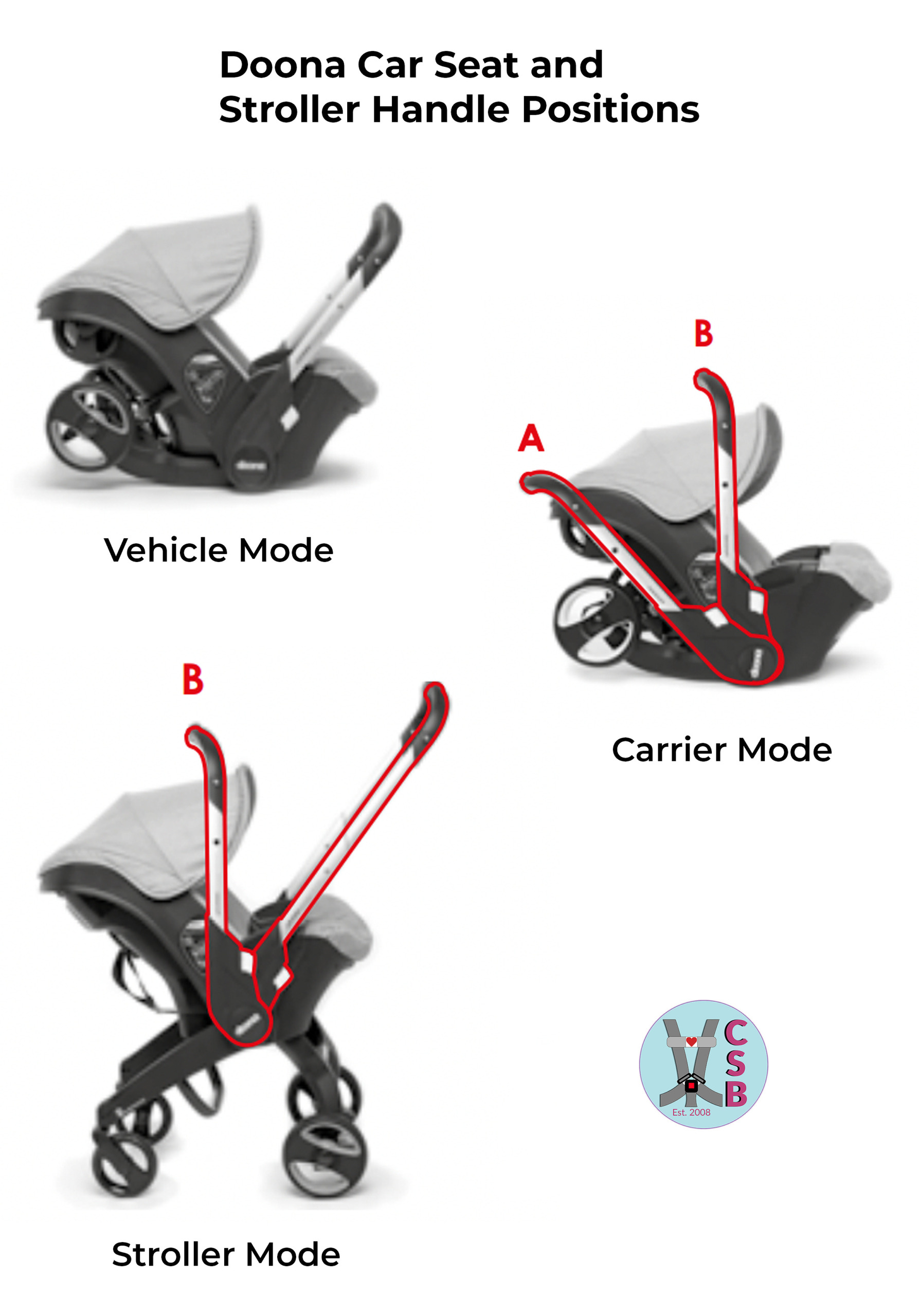
Fit-to-Child:
The weight limit starts at 4 lbs. When I tried the preemie doll in the seat, the shoulders were right at the bottom harness slots. I’d recommend placing a rolled washcloth between a very small baby and the crotch buckle to keep baby from sliding down toward the buckle at all. I’ve placed the preemie doll next to full-term infants and feel comfortable saying it’s the size of a 6 lbs. full-term newborn. Our model is 7 lbs. and comparable to the preemie doll in size.
For height, use the closest harness slot that’s at or below the child’s shoulder.
Head and Body Support Inserts:
The optional head pillow can be removed at any time; however, Doona strongly suggests using it at all times, even after removing the infant insert.
You must use the infant insert until your child reaches 11 lbs. or if their shoulders are below the bottom harness slots.
Harness pads are optional. The owner’s manual states that Doona recommends using them.
My little model is 3 weeks old, about 7 lbs., and fit in the Doona very well. She dozed through the fitting in the Doona, in part to being pushed in the stroller. She’s a stroller girl! The smooth harness was easy to adjust on her.

When installed in a vehicle, the handle should be placed all the way forward toward the feet so it can act as an anti-rebound bar.
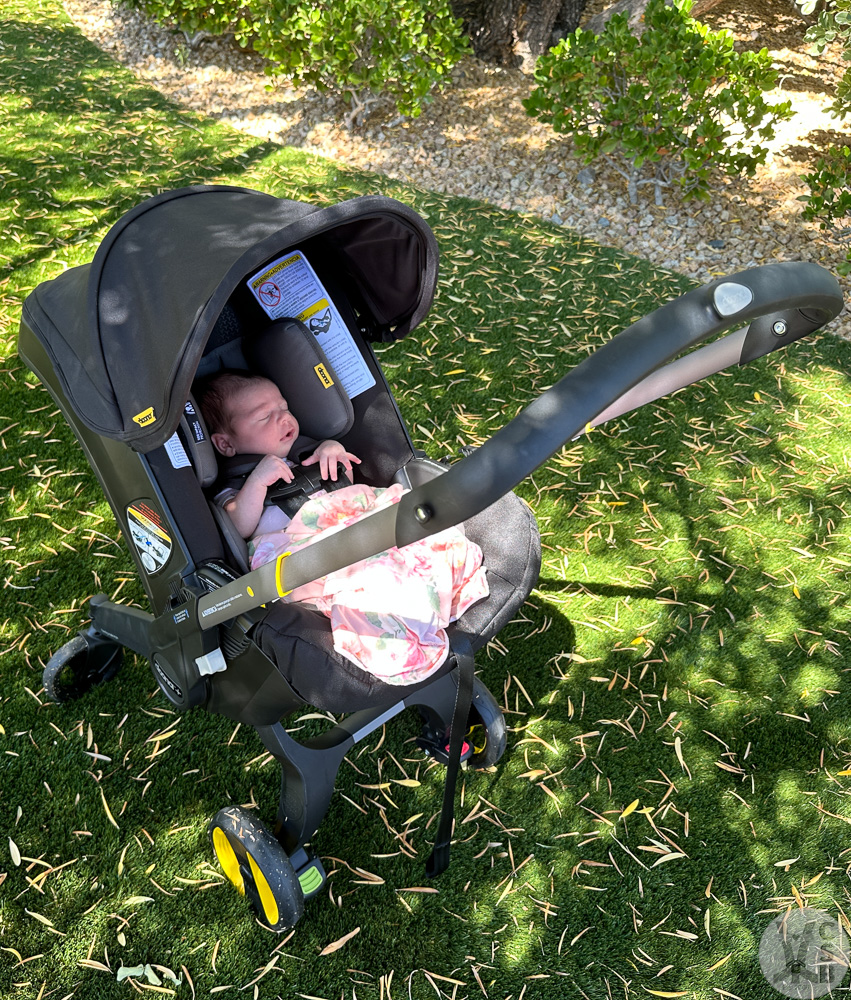
Cover/Ease of Use/Maintenance:
Removing the cover for cleaning is easy and it’s easiest if you remove the canopy first as well as undo the harness from the metal splitter plate on the back of the seat. The way the cover is fastened to the seat makes for a cover that doesn’t move around when in use and also makes it easy to know how to put it back on.
Despite using some elastics to secure the cover to the top of the shell, I actually love the way Doona anchored them. The elastics are thicker, more like the kind you’d find in a waistband, and the ends have a plastic tab which hook over a plastic piece on the shell. It’s very secure. I wish some other manufacturers would do the same (I’m looking at you, Graco and Britax!).
💡 Always take pics or a video as you take the cover off so you know which harness and buckle slots to use and where to tuck elastics. While the manual has great step-by-step pictures on how to remove and replace the cover, Doona also has a good video on changing the cover.
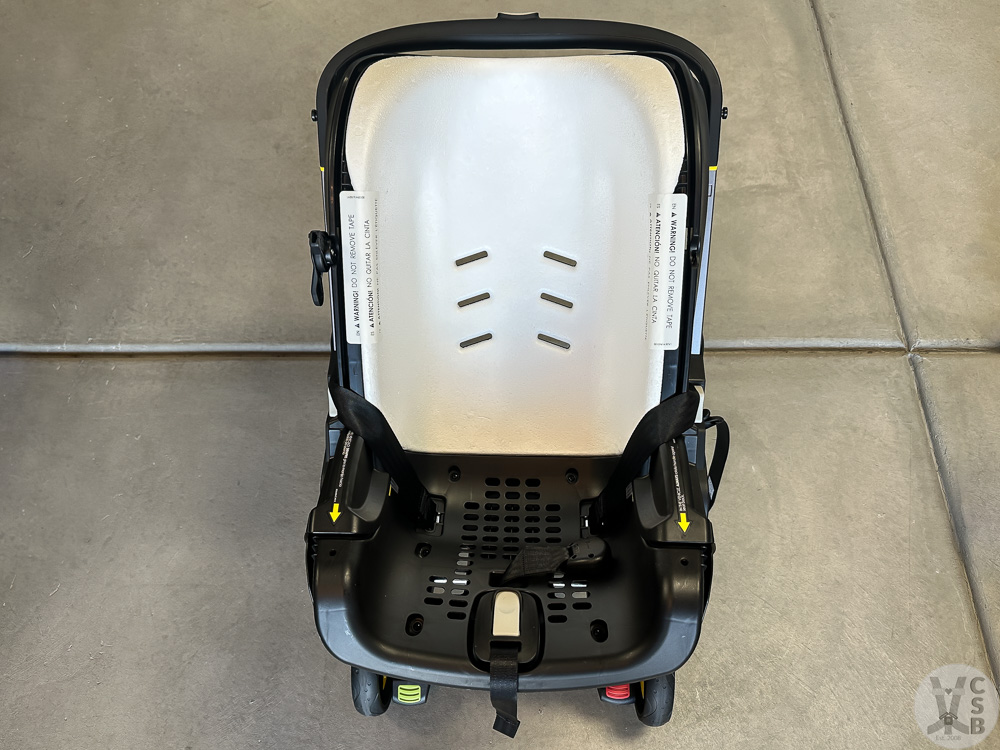
As easy as I found the cover to remove, I had a terrible time removing the canopy. First I read the instruction manual. Then I read it again. I read it for a third time when my canopy refused to budge. Then I watched the video, which showed the canopy coming off for the model caregiver so easily. One side of my canopy eventually came off, but I had to stand in my carrier and pull hard before the entire assembly pulled out, which was clearly not supposed to happen. I was able to get it put back in easily, but 🤨.
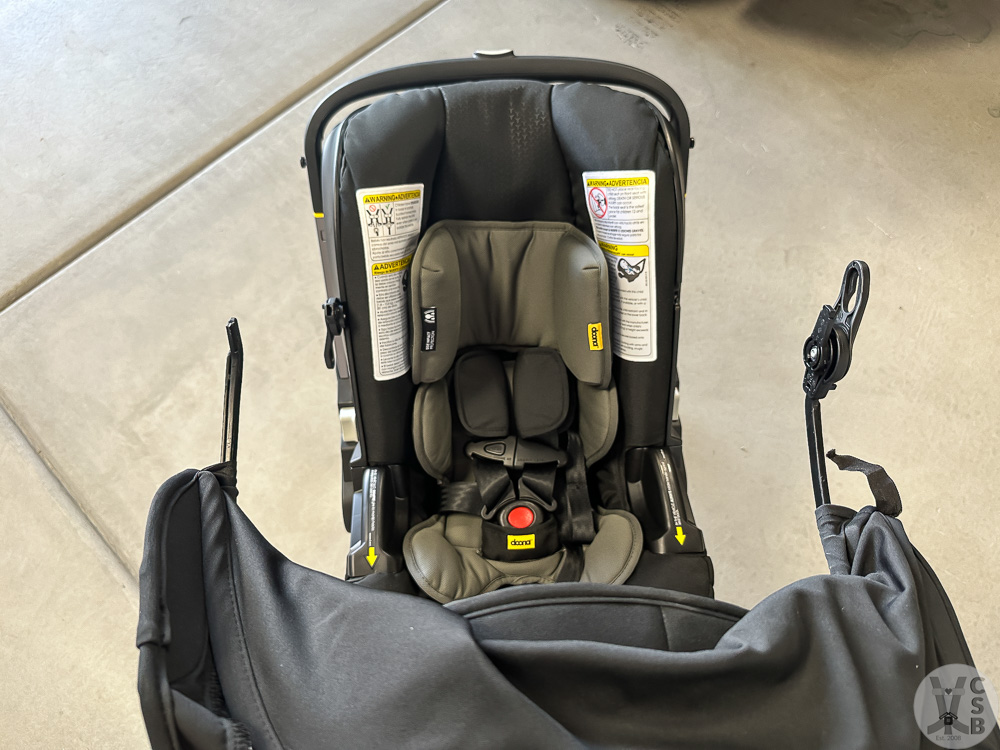
The harness is not replaceable, so take care to follow instructions when cleaning and stay on top of keeping it clean.
To clean the harness, wipe with a wet washcloth and towel dry. DO NOT use chemicals on it.
FAA-Approval/Lifespan/Crash Guidelines:
FAA certified for use on airplanes without the base
6 year lifespan before expiration
🚗💥 🚙 The Doona must be replaced after a moderate to severe crash, using NHTSA guidelines:
The vehicle is able to be driven away from the crash site.
The vehicle door nearest the car seat is not damaged.
None of the passengers in the vehicle were injured in the crash.
If the vehicle has air bags, the air bags did not deploy during the crash; and
There is no visible damage to the car seat.
SensAlert Bluetooth Child Detection System:
Doona calls SensAlert an “anti-abandonment” system because it was developed and first used in Europe, which is what the systems are called there. It seems like a rather harsh term to me since the vast majority of kids left in vehicles in the states aren’t abandoned, which implies intent; however, since Doona is so closely tied with their EU side, it follows that they kept the terminology.
SensAlert is a stiff foam pad that is placed over the buckle in the Doona and the child sits on top of it and harnessed as usual. Doona says it can be used in all carseats, but ask any other manufacturer if they’ll allow it and you’ll get a negative response so consider this a Doona-only product for now. The sensors detect the child’s weight and send signals via Bluetooth to an app on your phone. I forgot to take the SensAlert when taking photos with our model, so Romeo and my preemie doll were glad to sit in her place.
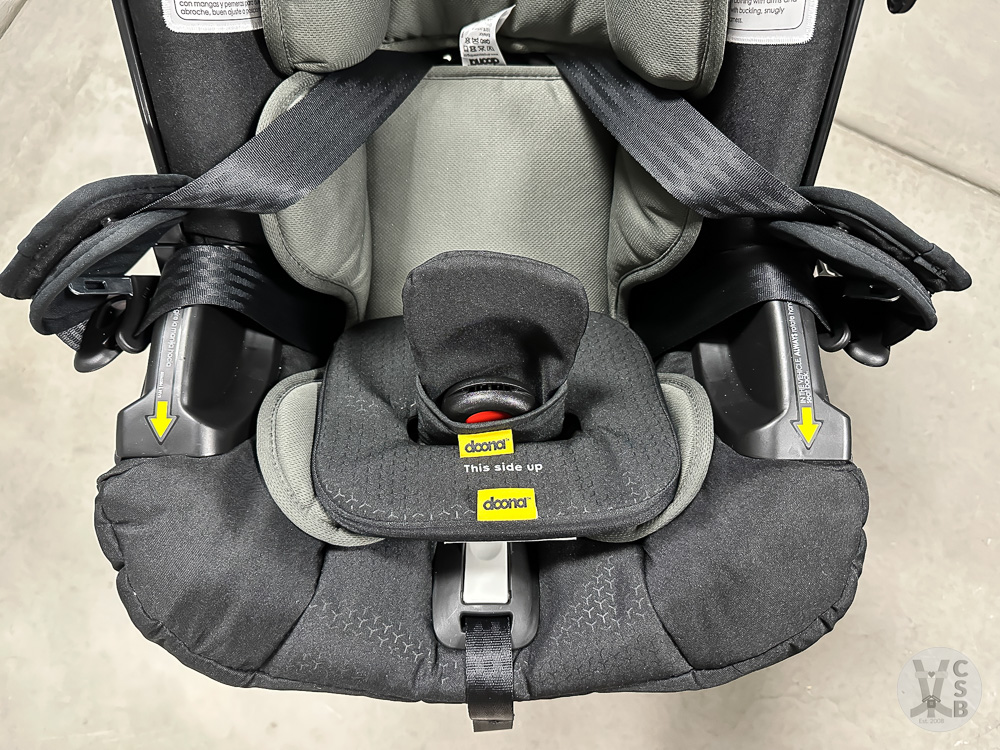
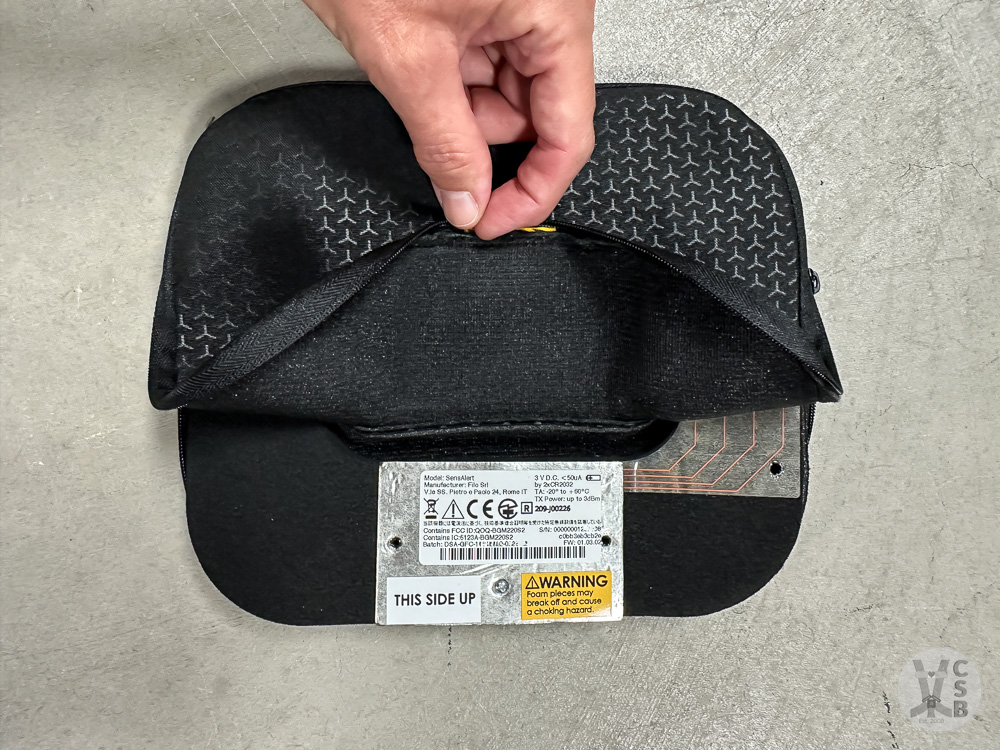

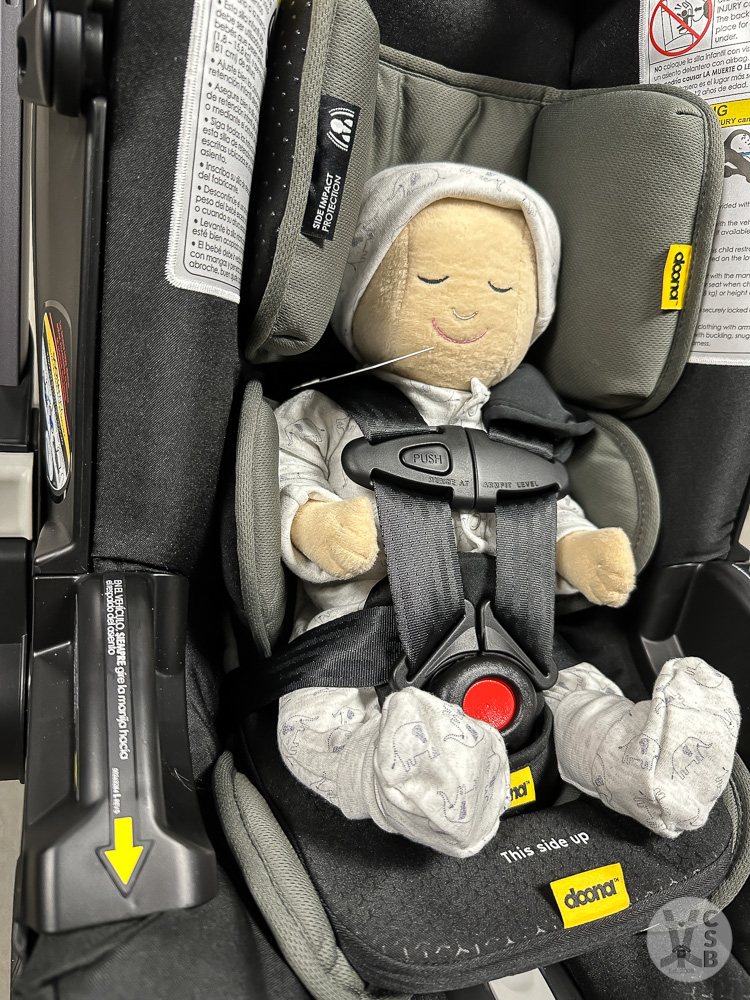
I stuck a thin ruler on top of the preemie doll’s right shoulder so you can see where the harness slot is
If you leave your child behind in the vehicle, after 3 minutes, you’ll receive a sound alert, even if your phone is set to silent, which you must turn off through the app.
If you don’t turn that alert off, you’ll receive a phone call as a 2nd alert after 4 minutes. You’ll receive instructions during the call on how to disable the alarm.
If you still don’t disable the alert, a 3rd alarm alert is sent after 7 minutes in the form of phone calls to the emergency contacts listed in the app. They can choose to disable the alarm or receive a text with the child’s GPS position.
SensAlert is powered by two CR 2032 batteries, which are fortunately pretty easy to find at grocery stores. The FAQ on the Doona website gives instructions on how to change the batteries.
Fake/Knockoff Doonas:
I know it’s so tempting to try to save money on baby stuff anywhere you can because it’s all so expensive. But these carseat and stroller combinations are safety devices and since they are combination devices as well, they won’t be cheap. If you notice one that’s too good of a deal, it’s likely not the real thing. We have an article to help you figure out what’s fake and what’s not.
Doona Advantages:
Converts to stroller/back to carseat with one handle
Thick EPS foam
Euro belt path allowed when installed without the base
Follows NHTSA guidelines for replacement after a crash
Large canopy is water repellent and has a UPF of 50+
Smooth adjusting harness
Available SensAlert child detection system
Well-padded
Rolls smoothly as a stroller
Disadvantages:
(In fairness, these aren’t necessarily problems but I list them here to inform potential consumers of specific Doona issues)
It’s HEAVY
No true lockoffs on base or carseat/stroller itself; must use locking clip when traveling internationally without the base
Short handle may be uncomfortable for taller parents
Once your child outgrows the carseat (typically around 12 months), you will need to purchase a new car seat AND a new stroller
No option for chemical flame-retardant-free cover
Conclusion:
Like any carseat or stroller on the market, you have to pick the one that fits your lifestyle, vehicle, and child best. It’s extra hard with infant seats because you’re playing a guessing game since the main player hasn’t arrived yet! The Doona goes from house to car to store without a hitch. It converts between carseat and stroller smoothly and rolls surprisingly well in stroller mode, as long as you’re on not planning to go off road with it.
The biggest downside of the Doona is its sheer weight. At 17 lbs. without a baby in it, you’re looking at 23-25 lbs. of lifting off the ground, right from the start—and it only gets heavier as your baby grows. If you wind up delivering by c-section, there is no way you’re lifting a Doona in and out of the car for the first 4-6 weeks while you recover. On the upside, you can skip arm days at the gym once you’re ready to start working out again.
Thank you to Doona for providing the Doona Car Seat & Stroller used for this review. No other compensation was provided. All opinions expressed are those of CSB.







